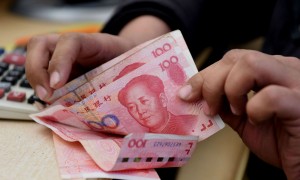Chinese yuan could become reserve currency for African central banks
May 30, 2018—Many east and southern African governments have of recent increased their indebtedness with China and there are talks underway to decide whether to add the Chinese yuan also known as a renminbi, as a reserve currency for the region.

In September 2016, the IMF accepted the Chinese yuan in its basket of reserve currencies to join the US dollar, yen euro, and British pound.
The talks end today in Harare, Zimbabwe with officials from the African Development Bank having an oversight role.
Most African central bank reserves are in United States dollars, but the rapid rise of China as now the world’s second biggest economy, has made yuan transactions more prevalent. About 30% of Uganda’s total foreign debt is owed to the Chinese government, mainly by way of concessional loans through the China Eximbank.
Meeting under the auspices of the Financial Management Institute of Eastern and Southern Africa (MEFMI), deputy permanent secretaries and deputy central bank governors will also strategize on the weakening external positions of most member countries, following the global economy slowdown.
Gladys Siwela-Jadagu, the MEFMI spokesperson said, ““Ascendancy of Chinese yuan in the Special Drawing Rights (SDR) basket of currencies is an important symbol of its importance and the International Monetary Fund’s approval as an official reserve currency.”
Officials said many MEFMI member states have loans or grants from China and it makes economic sense to repay in Chinese currency, because the yuan has also become what may be termed ‘common currency’ in trade with Africa.
Angola, Botswana, Burundi, Kenya, Lesotho, Malawi, Mozambique, Namibia, Rwanda, Swaziland, Tanzania, Uganda, Zambia and Zimbabwe are member states of MEFMI.
“As at the end of 2017, official reserves for most countries in the MEFMI region stood barely at or below the traditional three months of import cover benchmark. Foreign currency denominated public debt continues to increase as well as interest payments, as most countries move to more commercial sources of borrowing to meet their increasing appetite for infrastructure projects,” she said.
She cautioned that Africa could not afford to lag behind in taking advantage of growth-enhancing opportunities with China, as it had been clear over the last five years that trade and investment with the West continued to be limited.
She said, “With China as the largest trading partner of over 130 countries, the main challenge for African countries is how to benefit from the new pattern of international commerce.”
Recently in Kampala, Stanbic Bank and the Industrial and Commercial Bank of China (ICBC) celebrated 10 years of partnership by hosting a high level business forum for members of the Ugandan/China business community. Stanbic is Uganda’s top dealer in yuan transactions.
Patrick Mweheire, the Stanbic Bank Uganda Chief Executive said in his opening remarks, “China is Africa’s most important trading partner having generated over $300 billion worth of business in 2017 alone. This figure has grown nearly tenfold over the past decade and is one of the main reasons the continent has witnessed such a rapid economic growth over the period.”
He told the mixed gathering of Chinese and Ugandans, “Our objective as Stanbic in hosting this forum is to provide a strategic platform that promotes constructive dialogue between like-minded Ugandan and Chinese businesses so they can tap into multiple opportunities the relationship between our two banks offers.”


 African Heads of state head to South Korea next week for Summit talks
African Heads of state head to South Korea next week for Summit talks
 Trading leads as main source of income for Ugandans
Trading leads as main source of income for Ugandans
 New leadership for bankers’ umbrella as total assets top $12 billion
New leadership for bankers’ umbrella as total assets top $12 billion
 Brussels Airlines to announce Nairobi service
Brussels Airlines to announce Nairobi service
 SITA promises enhanced travel experience after Materna acquisition
SITA promises enhanced travel experience after Materna acquisition
 Saudia’s 105 aircraft order stretches A320neo lead over rival Max
Saudia’s 105 aircraft order stretches A320neo lead over rival Max
